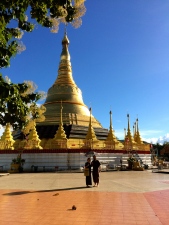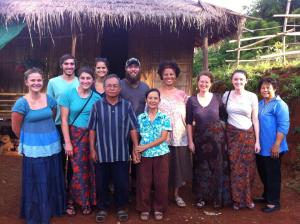Finally! Another post! Sorry if you’ve been patiently waiting on the edge of your seat (although I’m sure my blog is hardly at the top of anyones priority list, nor should it be!).
SO much has taken place since we started classes & I haven’t given myself a proper amount of down time to try & process it all nonetheless form it into a decent “blog ready” post. So forgive me, I’m not quite there yet, BUT I will, for the sake of my friends and family, try and consolidate these past few weeks (probably more specifically this weekend) into decent blog post.
Currently, I’m sitting at a coffee shop down the road from the GO ED. house/TLCC campus. A Thai woman named Joy, a savvy & dedicated business person, runs it. She is fun, has great english and is an excellent resource when it comes to learning Thai and asking questions about Thai culture. Her coffee shop, only a short bike ride away, has proven to be a great place to get away and focus on different tasks–homework, reading, journaling, updating social media, & of course enjoying a cold/hot beverage for a great price.
This is my current reality!
(Yes, that is a waterfall & a cha-yen (Thai iced tea) all for 25baht (approx. 30ish baht to $1 USD))

Over the weekend we took a class field trip to the Golden Triangle, where Thailand, Burma & Laos come together on the mighty Mekong River.


Our goal was to build upon what we’ve been studying in class about the history, society & religion of the GMS (Greater Mekong Sub-region) & issues of exclusion & exploitation. This field experience gave us first hand exposure to what we’ve been learning about from a distance during class in the library at McGilvary College of Divinity every Monday, Wednesday & Friday.
Through much repetition and overlap in our two classes, accompanied by this recent trip to the the physical locations we are studying, along with hearing first hand from real people actually dealing with these important issues/realities, I’m still only beginning to form a basis of general understanding in regards to this region and its areas of conflict/issue.
Over the weekend we spent time on the border of Myanmar (Burma) and Thailand in Mae Sai–a well known area for the use of trafficked and marginalized people— most commonly ethnic minorities of Burma. In this area particularly Shan women are exploited as sex workers and laborers.
On Saturday, after quite the drive, we took a boat ride along a portion of the Mekong River & stopped in Laos for a short while to check out a small tourist market.


That evening we met up with a small youth group at a local church that was made up of young Shan women & men, living in Mae Sai lacking citizenship (an all too common occurrence). We were able to worship together, share our stories & hear some of theirs.
Later that night we drove around to observe a well-known red light district, which apparently used to be a bit more obvious, & out in the open, but due to the new government change and the increased crack-down by police (because prostitution is illegal in Thailand), much of the red-light business has been moved underground.
We ended the night hearing from Bua, a Shan woman from Burma who has dedicated herself to working with the Shan women and youth across the border in Mae Sai. She explained some of the reasons behind women coming from Burma to work as sex-workers across the border. The stories she shared were heartbreaking. As outsiders, we have such a limited view and understanding of such an intense and complicated issue. We can talk about the theories of Human Trafficking and discuss the many complexities of how and why people are trafficked, but even then, without experiencing it ourselves (God-forbid), we really can never understand the evil at hand completely.
[In another blog, I’ll do my best to run through some of the topics we’ve been discussing and studying in class & on the field in greater depth, but for now I’ll simply recap the rest of our trip.]
Sunday morning we crossed into Burma (Officially Myanmar, but I like Burma better) for church.

We met up with Bua & our guide Mo Kham who took care of all our passports & paperwork to get in/out of Burma (thank God for her!). After an hour or so of waiting we finally made our way to Bua’s village in the Shan state or Burma–about an hour off the border. It was a beautiful time of fellowship, worship and community. Bua preached (in 3 languages mind you-Shan, Burmese & recapped in English)! She’s AMAZING. I even got to share a bit about my heart for missions and the importance of intentional community.
Then we ended our time with a wonderful lunch of traditional Shan food shared by many. Before we left we prayed with the founder of the village church on behalf of his health.

Our time in Burma ended with a stop at Mo Kham’s family organic dragon fruit farm, a quick trip to the pagoda, a tea shop (DELICIOUS!), & an attempt to catch the end of the border market.



Monday morning started of with a trip to DEPDC (Development and Education Program for Daughters and Communities) an organization that aims to “prevent and protect children (boys & girls) in Thailand from exploitation and trafficking.” They do this through providing education for children and community members via school/training and even safe-houses in emergency situations. It was interesting to see a non-faith based organization’s model on social work and prevention.
On our way back to Chiang Mai we had the awesome privilege of stopping in a Lahu village & meeting this incredible man and his wife!


Mr. Duangthip is a spectacular human being. He is yellow Lahu (one of 12 sub-groups of Lahu). At age 10, he walked with is family from Burma to Thailand. At that time they only had pieces of paper with some songs and scripture written only in Black Lahu (most Lahu groups can understand Black Lahu, but many others, if any, can understand yellow). Upon arrival & years later in cooperation with a foreign missionary, Ajarn Duangthip worked diligently to gain rights and land for his people. He is well respected and is currently working on Bible translation for his people (Yellow Lahu) as well as another sub-group. When he began, the Yellow Lahu had no alphabet, now the book on the left contains portions of scripture and the book on the right contains songs of praise, both in Yellow Lahu. Though I’m only able to relay a portion of this mans great accomplishments, the short time we had to hear about his life & see his village/home will stick with me & his smile, which conveys so much joy, will remain in my heart. He & his wife co-pastor the village church. She was delightful by the way! She welcomed us into their beautiful traditional Lahu home and enthusiastically showed us around, demonstrating the uses of different things, even how to put together Lahu roofing!
This weekend was an all around great experience. Challenging at times, hard to hear and see the harsh realities that surround us, but my biggest take aways were from the incredible people we met.
A common debate heard within Christian circles that came to mind for me this weekend when thinking about logical solutions to an issue as deep & as wide as human trafficking, now grasping the severity and vastness of its underlying causes, is the concept of Social Gospel vs. Salvation Gospel. (Roughly) Most either believe that only salvation of the soul is necessary and what ever happens to the body is whatever because it’s only temporary, and others believe that salvation comes second to our social responsibility to meet the needs of people facing injustices.
It’s sad that this topic becomes an either/or debate, because these two concepts need to go hand in hand. They cannot be separated.
But I would be a hypocrite if I didn’t honestly admit that it’s easy to fall one way or the other. It’s the easy way out. Preaching one is less work than pairing the two together in holistic fashion, because taking a holistic approach (which I believe Jesus did) take more time, effort & care. If I may be honest, my tendencies lately have found me leaning more towards the social gospel side of things. Why do I need to physically preach the gospel and feel obligated to inquiring someones personal salvation? Why can’t I just set an example through actions in serving those in need and allow them to make their own decision about their own spiritual lives? (Very individualistic wouldn’t ya say?)
But over the past few weeks and especially after this weekend (& in light of our two classes last week hearing from a highly respected Buddhist monk about the teachings of Buddhism), my eyes have been opened.
I knew in my head that Social & Salvation gospel are to be one, but until you strip away the underlying causes of these social injustices & get to the bottom & realize there is no hope & no end without the saving power & ultimate grace of Jesus Christ, does that become a reality, a true necessity.
In a country enveloped by Buddhist religion and culture, where teachings of detachment & karma become more like fatalism, entrapping people in the belief that their only option is to except their fate in suffering, because nothing they can ever do has the ability to change what they’ve done in previous past lives. There is no looking forward & they don’t believe anyone can save them, they’re on their own.
When facing injustices rooted in such evil and darkness, there is no other way to battle it than from both sides. People suffering from the vast amounts of injustices that feed into trafficking NEED a savior to believe in. The Gospel of Jesus Christ is the only sense of hope in a situation as dark as this. Christ instills change and He raises up people like you & me to be apart of that change. When lust & greed are lurking at the basis of such crimes, a change of heart must be at the basis of the solution.
Bottom line, we need to come at issues holistically. Ministering to both the physical body and the immortal soul. We need people to physically rescue trafficked victims, we need people to educate at-risk communities, we need people to confront corruption in government and law-enforcement, etc. but we need to do all those things in the name of Christ, calling upon Him to work behind the scenes, in the hearts of His people, we must be praying for our enemies & speaking life over their victims.
The outstanding people we met this weekend are doing this.
What are we doing with our lives to honor God and bring hope and dignity to His people?